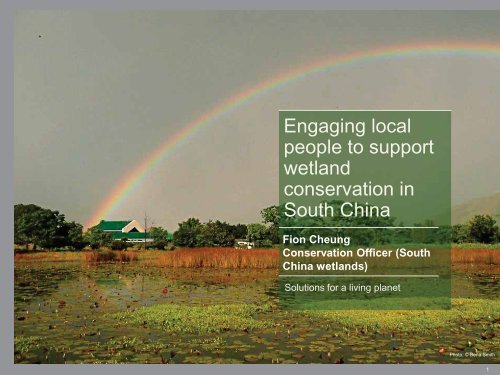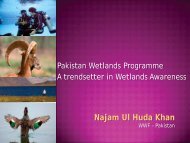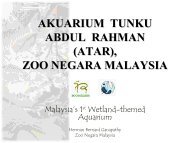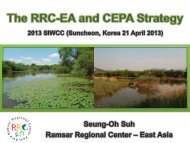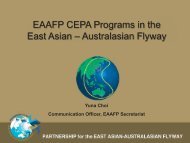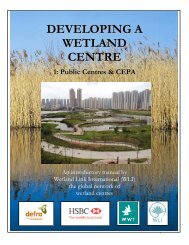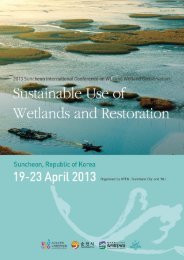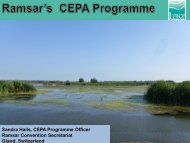Fion Cheung, WWF Hong Kong - Wetland Link International
Fion Cheung, WWF Hong Kong - Wetland Link International
Fion Cheung, WWF Hong Kong - Wetland Link International
You also want an ePaper? Increase the reach of your titles
YUMPU automatically turns print PDFs into web optimized ePapers that Google loves.
Engaging localpeople to supportwetlandconservation inSouth China<strong>Fion</strong> <strong>Cheung</strong>Conservation Officer (SouthChina wetlands)Solutions for a living planet© Michel Roggo / <strong>WWF</strong>-CanonPhoto: © Bena Smith1
Engaging local people to support wetland conservation in South ChinaMai PoNatureReservePresentation to Suncheon <strong>International</strong> Conference on WLI and <strong>Wetland</strong> ConservationSolutions for a living planet
Engaging local people to support wetland conservation in South China<strong>Wetland</strong> Management Training Programme• Started in 1991• Site managers and decision makers related to themanagement and conservation of wetlands along theEAA Flyway• 8-day training at Mai Po Nature Reserve– Introduction of Ramsar;– <strong>Wetland</strong> management work in Mai Po;– <strong>Wetland</strong> monitoring;– <strong>Wetland</strong> restoration;– Preparation of wetland management plan• ~150 per yearPresentation to Suncheon <strong>International</strong> Conference on WLI and <strong>Wetland</strong> ConservationSolutions for a living planet
Engaging local people to support wetland conservation in South China<strong>Wetland</strong> Management Training Programme• “The content of the training is good but the situation of ournature reserve is much more complicated than Mai Po…”• “…don’t know whether I can use the knowledge directly inour site…”• “Local communities living inside the nature reserveburden our wetland management work…”• “We face difficulties in dealing with the local governmentand local communities…”Presentation to Suncheon <strong>International</strong> Conference on WLI and <strong>Wetland</strong> ConservationSolutions for a living planet
Engaging local people to support wetland conservation in South ChinaHSBC/<strong>WWF</strong> South China <strong>Wetland</strong>s Project• Started in July 2005• Models of wetland nature reserve in mainland ChinaPresentation to Suncheon <strong>International</strong> Conference on WLI and <strong>Wetland</strong> ConservationSolutions for a living planet
Engaging local people to support wetland conservation in South ChinaHSBC/<strong>WWF</strong> South China <strong>Wetland</strong>s Project• Started in July 2005• Models of wetland nature reserve in mainland ChinaPresentation to Suncheon <strong>International</strong> Conference on WLI and <strong>Wetland</strong> ConservationSolutions for a living planet
Engaging local people to support wetland conservation in South ChinaZhangjiang EstuaryMangrove National NRMai Po NRHaifeng BirdProvincial NRPresentation to Suncheon <strong>International</strong> Conference on WLI and <strong>Wetland</strong> ConservationSolutions for a living planet
Engaging local people to support wetland conservation in South ChinaImportance of the sites• Stopover/wintering sites of migratory waterbirds at the EAAFlyway1. Zhangjiang Estuary Mangrove National NR (2,360 ha)– Largest area of natural mangrove in Fujian Province2. Haifeng Bird Provincial NR (11,588 ha)– >20,000 wintering waterbirds;– Rare bird species (Black-faced Spoonbill, Nordmann’sGreenshank, Purple Swamphen)Presentation to Suncheon <strong>International</strong> Conference on WLI and <strong>Wetland</strong> ConservationSolutions for a living planet
Engaging local people to support wetland conservation in South ChinaImportance of the sites• Stopover/wintering sites of migratory waterbirds at the EAAFlyway1. Zhangjiang Estuary Mangrove National NR (2,360 ha)– Largest area of natural mangrove in Fujian Province2. Haifeng Bird Provincial NR (11,588 ha)– >20,000 wintering waterbirds;– Rare bird species (Black-faced Spoonbill, Nordmann’sGreenshank, Purple Swamphen)Presentation to Suncheon <strong>International</strong> Conference on WLI and <strong>Wetland</strong> ConservationSolutions for a living planet
Engaging local people to support wetland conservation in South ChinaImportance of the sites• Stopover/wintering sites of migratory waterbirds at the EAAFlywayBlack-faced Spoonbill1. Zhangjiang Estuary Mangrove National NR (2,360 ha)– Largest area of natural mangrove in Fujian Province2. Haifeng Bird Provincial NR (11,588 ha)Purple Swamphen– >20,000 wintering waterbirds;– Rare bird species (Black-faced Spoonbill, Nordmann’sGreenshank, Purple Swamphen)Presentation to Suncheon <strong>International</strong> Conference on WLI and <strong>Wetland</strong> ConservationSolutions for a living planet
Engaging local people to support wetland conservation in South ChinaSpecific difficulties in Zhangjiang Estuary NR• About 10,000 people living in 2 villages next to the NR• Human disturbance– Harvesting mudflat products (razor clam);– Intensive aquaculture on mudflat• Unwise use of mudflat– Env. unfriendly aquaculture methodCo-management+Alternative incomePresentation to Suncheon <strong>International</strong> Conference on WLI and <strong>Wetland</strong> ConservationSolutions for a living planet
Engaging local people to support wetland conservation in South ChinaCo-managementStep 1: Conduct socio-economic surveyPresentation to Suncheon <strong>International</strong> Conference on WLI and <strong>Wetland</strong> ConservationSolutions for a living planet
Engaging local people to support wetland conservation in South ChinaCo-managementStep 1: Conduct socio-economic survey- Great economic dependency on the mudflat interms of razor clam raising;- Key source of human disturbanceStep 2: Review the current razor clam raising practices andtechniques on mudflat- Bring a lot of human disturbance;- Use of env. harmful insecticide (Triazophos)Presentation to Suncheon <strong>International</strong> Conference on WLI and <strong>Wetland</strong> ConservationSolutions for a living planet
Engaging local people to support wetland conservation in South ChinaCo-managementStep 1: Conduct socio-economic survey- Great economic dependency on the mudflat interms of razor clam raising;- Key source of human disturbanceStep 2: Review the current razor clam raising practices andtechniques on mudflat- Bring a lot of human disturbance;- Use of env. harmful insecticide (Triazophos)Step 3: Explore more sustainable ways in raising razor clamwith lesser human disturbance- Raise razor clam in pondsPresentation to Suncheon <strong>International</strong> Conference on WLI and <strong>Wetland</strong> ConservationSolutions for a living planet
Engaging local people to support wetland conservation in South ChinaCo-managementStep 4: Organize study tours to other razor clam pondraisingsites- learn skills and techniques to improve the incomeStep 5: Publication of Razor Clam Culture and the Control ofWater Colour- Guide the pond-raising processPresentation to Suncheon <strong>International</strong> Conference on WLI and <strong>Wetland</strong> ConservationSolutions for a living planet
Engaging local people to support wetland conservation in South ChinaCo-managementStep 4: Organize study tours to other razor clam pondraisingsites- learn skills and techniques to improve the incomeStep 5: Publication of Razor Clam Culture and the Control ofWater Colour- Guide the pond-raising processPresentation to Suncheon <strong>International</strong> Conference on WLI and <strong>Wetland</strong> ConservationSolutions for a living planet
Engaging local people to support wetland conservation in South ChinaCo-managementStep 6: Stop the use of env. harmful insecticideNo harvestStep 7: Replace it by substitute- Prove the effectiveness of the substitute by experiment;- Substitute: Better profit + faster recovery of benthos;- Regulation: Ban the use of the env. harmful one;- Promote the use of substitute in workshopsPresentation to Suncheon <strong>International</strong> Conference on WLI and <strong>Wetland</strong> ConservationSolutions for a living planet
Engaging local people to support wetland conservation in South ChinaAlternative incomeStep 1: Set up aquaculture experimentsmulti-trophic VS mono-trophic (crab)>RMB5,000/acreRMB2,500 – 3,000/acreStep 2: Organize training workshops about multi-trophicaquacultureStep 3: Establish an Aquaculture Association- Exchange experience in operating the multi-trophicaquaculture pondsPresentation to Suncheon <strong>International</strong> Conference on WLI and <strong>Wetland</strong> ConservationSolutions for a living planet
Engaging local people to support wetland conservation in South ChinaAlternative incomeStep 1: Set up aquaculture experimentsmulti-trophic VS mono-trophic (crab)>RMB5,000/acreRMB2,500 – 3,000/acreStep 2: Organize training workshops about multi-trophicaquacultureStep 3: Establish an Aquaculture Association- Exchange experience in operating the multi-trophicaquaculture pondsPresentation to Suncheon <strong>International</strong> Conference on WLI and <strong>Wetland</strong> ConservationSolutions for a living planet
Engaging local people to support wetland conservation in South ChinaAlternative incomeStep 4: Apply for “Certificate of Non-harmful AquacultureProducts”Unit price Income Multi-trophic• EcotourismPresentation to Suncheon <strong>International</strong> Conference on WLI and <strong>Wetland</strong> ConservationSolutions for a living planet
Engaging local people to support wetland conservation in South ChinaImprove the living standard of local community1: Develop garbage collection system2: Build eco-friendly toiletsPresentation to Suncheon <strong>International</strong> Conference on WLI and <strong>Wetland</strong> ConservationSolutions for a living planet
Engaging local people to support wetland conservation in South ChinaImprove the living standard of local community1: Develop garbage collection system2: Build eco-friendly toiletsPresentation to Suncheon <strong>International</strong> Conference on WLI and <strong>Wetland</strong> ConservationSolutions for a living planet
Engaging local people to support wetland conservation in South ChinaImprove the living standard of local community1: Develop garbage collection system2: Build eco-friendly toiletsPresentation to Suncheon <strong>International</strong> Conference on WLI and <strong>Wetland</strong> ConservationSolutions for a living planet
Engaging local people to support wetland conservation in South ChinaImportance of the sites• Stopover/wintering sites of migratory waterbirds at the EAAFlyway1. Zhangjiang Estuary Mangrove National NR (2,360 ha)– Largest area of natural mangrove in Fujian Province2. Haifeng Bird Provincial NR (11,588 ha)– >20,000 wintering waterbirds;– Rare bird species (Black-faced Spoonbill, Nordmann’s Greenshank,Purple Swamphen);– 3 separated parts;– Traditional operation method of aquaculture ponds is beneficial toboth human and wildlifePresentation to Suncheon <strong>International</strong> Conference on WLI and <strong>Wetland</strong> ConservationSolutions for a living planet
Engaging local people to support wetland conservation in South ChinaImportance of the sites• Stopover/wintering sites of migratory waterbirds at the EAAFlyway1. Zhangjiang Estuary Mangrove National NR (2,360 ha)– Largest area of natural mangrove in Fujian Province2. Haifeng Bird Provincial NR (11,588 ha)– >20,000 wintering waterbirds;– Rare bird species (Black-faced Spoonbill, Nordmann’s Greenshank,Purple Swamphen);– 3 separated parts;– Traditional operation method of aquaculture ponds is beneficial toboth human and wildlifePresentation to Suncheon <strong>International</strong> Conference on WLI and <strong>Wetland</strong> ConservationSolutions for a living planet
Engaging local people to support wetland conservation in South ChinaTraditional operation methodOctNovDecJanSepFebAugMarJulAprJunMayPresentation to Suncheon <strong>International</strong> Conference on WLI and <strong>Wetland</strong> ConservationSolutions for a living planet
y Peter Yip
Engaging local people to support wetland conservation in South ChinaTraditional operation methodOctNovDecJanSepAugHarvestingDrainingSun bakingFebMarJulAprJunMayPresentation to Suncheon <strong>International</strong> Conference on WLI and <strong>Wetland</strong> ConservationSolutions for a living planet
Engaging local people to support wetland conservation in South ChinaTraditional operation methodOctNovDecJanSepAugHarvestingDrainingSun bakingFebMarJulAprJunMayPresentation to Suncheon <strong>International</strong> Conference on WLI and <strong>Wetland</strong> ConservationSolutions for a living planet
Engaging local people to support wetland conservation in South ChinaTraditional operation methodOctNovDecJanSepAugHarvestingDrainingSun bakingFebMarJulAprJunMayPresentation to Suncheon <strong>International</strong> Conference on WLI and <strong>Wetland</strong> ConservationSolutions for a living planet
Engaging local people to support wetland conservation in South ChinaPresentation to Suncheon <strong>International</strong> Conference on WLI and <strong>Wetland</strong> ConservationSolutions for a living planet
Engaging local people to support wetland conservation in South ChinaSpecific difficulties in Haifeng NRLian’anwei• No control right on land use• Potential change of aquaculture method from thetraditional one to the intensive oneCo-managementPresentation to Suncheon <strong>International</strong> Conference on WLI and <strong>Wetland</strong> ConservationSolutions for a living planet
Engaging local people to support wetland conservation in South ChinaCo-managementStep 1: Conduct socio-economic survey- Most families depend on aquaculture (traditional /intensive one) to make a living;- learn the skills from others or by themselvesStep 2: Set up a demonstration site to compare theeconomic benefits and env. impacts between:TraditionalmethodVSIntensive aquaculture ofcrab and shrimpVSIntensiveshrimp monoculturePresentation to Suncheon <strong>International</strong> Conference on WLI and <strong>Wetland</strong> ConservationSolutions for a living planet
Engaging local people to support wetland conservation in South ChinaCo-managementTraditionalIntensive(crab + shrimp)Intensive shrimpmonocultureEconomicbenefit(RMB/ha)RiskAdverseenvironmentalImpact19,500 X5,200 XX27,800 XXXPresentation to Suncheon <strong>International</strong> Conference on WLI and <strong>Wetland</strong> ConservationSolutions for a living planet
Engaging local people to support wetland conservation in South ChinaCo-managementStep 3: Organize study tours to Mai Po NR- Introduce the wise use concept of wetlands;- Demonstrate how the traditional method is operated inMai Po;- Learn about the certification of organic produce in HKStep 4: Organize training workshops for pond operators- Promote the traditional method;- Techniques to improve the water quality in pondsStep 5: Produce a documentary to promote the merits of thetraditional methodPresentation to Suncheon <strong>International</strong> Conference on WLI and <strong>Wetland</strong> ConservationSolutions for a living planet
Engaging local people to support wetland conservation in South ChinaCo-managementStep 3: Organize study tours to Mai Po NR- Introduce the wise use concept of wetlands;- Demonstrate how the traditional method is operated inMai Po;- Learn about the certification of organic produce in HKStep 4: Organize training workshops for pond operators- Promote the traditional method;- Techniques to improve the water quality in pondsStep 5: Produce a documentary to promote the merits of thetraditional methodPresentation to Suncheon <strong>International</strong> Conference on WLI and <strong>Wetland</strong> ConservationSolutions for a living planet
Engaging local people to support wetland conservation in South ChinaSpecific difficulties in Haifeng NRStep 6: Sending samples to check the quality of the produceraised by the traditional methodStep 7: Help promote the produce raised by the traditionalmethod by producing leafletsPresentation to Suncheon <strong>International</strong> Conference on WLI and <strong>Wetland</strong> ConservationSolutions for a living planet
Engaging local people to support wetland conservation in South ChinaCommon difficulties faced by management bureau• Lack of well-trained staff• Lack of a practical management plan• Low public awareness on wetland conservation1. Training workshops for local educators;2. Develop Education for Sustainable Development (ESD)strategy for the NR;3. Build necessary education facilities;4. Develop education materials;5. Develop local green schoolsPresentation to Suncheon <strong>International</strong> Conference on WLI and <strong>Wetland</strong> ConservationSolutions for a living planet
Engaging local people to support wetland conservation in South ChinaCommon difficulties faced by management bureau• Lack of well-trained staff• Lack of a practical management plan• Low public awareness on wetland conservation1. Training workshops for local educators;2. Develop Education for Sustainable Development (ESD)strategy for the NR;3. Build necessary education facilities;4. Develop education materials;5. Develop local green schoolsPresentation to Suncheon <strong>International</strong> Conference on WLI and <strong>Wetland</strong> ConservationSolutions for a living planet
Engaging local people to support wetland conservation in South ChinaCommon difficulties faced by management bureau• Lack of well-trained staff• Lack of a practical management plan• Low public awareness on wetland conservation1. Training workshops for local educators;2. Develop Education for Sustainable Development (ESD)strategy for the NR;3. Build necessary education facilities;4. Develop education materials;5. Develop local green schoolsPresentation to Suncheon <strong>International</strong> Conference on WLI and <strong>Wetland</strong> ConservationSolutions for a living planet
Engaging local people to support wetland conservation in South ChinaCommon difficulties faced by management bureau• Lack of well-trained staff• Lack of a practical management plan• Low public awareness on wetland conservation1. Training workshops for local educators;2. Develop Education for Sustainable Development (ESD)strategy for the NR;3. Build necessary education facilities;Presentation to Suncheon <strong>International</strong> Conference on WLI and <strong>Wetland</strong> ConservationSolutions for a living planet
Engaging local people to support wetland conservation in South ChinaCommon difficulties faced by management bureau• Lack of well-trained staff• Lack of a practical management plan• Low public awareness on wetland conservation1. Training workshops for local educators;2. Develop Education for Sustainable Development (ESD)strategy for the NR;3. Build necessary education facilities;4. Develop education materials;Presentation to Suncheon <strong>International</strong> Conference on WLI and <strong>Wetland</strong> ConservationSolutions for a living planet
Engaging local people to support wetland conservation in South ChinaCommon difficulties faced by management bureau• Lack of well-trained staff• Lack of a practical management plan• Low public awareness on wetland conservation1. Training workshops for local educators;2. Develop Education for Sustainable Development (ESD)strategy for the NR;3. Build necessary education facilities;4. Develop education materials;Presentation to Suncheon <strong>International</strong> Conference on WLI and <strong>Wetland</strong> ConservationSolutions for a living planet
Engaging local people to support wetland conservation in South ChinaCommon difficulties faced by management bureau• Develop local green schoolsPresentation to Suncheon <strong>International</strong> Conference on WLI and <strong>Wetland</strong> ConservationSolutions for a living planet
Engaging local people to support wetland conservation in South ChinaLong term protection of the two sites• 2nd February 2008Presentation to Suncheon <strong>International</strong> Conference on WLI and <strong>Wetland</strong> ConservationSolutions for a living planet
Engaging local people to support wetland conservation in South ChinaConclusions• Have a good understanding on the local situation,esp. socio-economic• Explore ways to use wetlands wisely• Engage the local people in the project• Raise public awareness and gain their supportCommunicationPresentation to Suncheon <strong>International</strong> Conference on WLI and <strong>Wetland</strong> ConservationSolutions for a living planet
Thank youwwf.org.hk© 2010, <strong>WWF</strong>. All photographs used in this presentation are copyright protected and courtesy of the <strong>WWF</strong>-Canon Global Photo Network and the respective photographers.Presentation to Suncheon <strong>International</strong> Conference on WLI and <strong>Wetland</strong> ConservationSolutions for a living planet
<strong>WWF</strong>-HONG KONG+100<strong>WWF</strong>’s networkis active in over100 countries+35,000<strong>WWF</strong>-<strong>Hong</strong> <strong>Kong</strong> hasover 35,000 individualfinancial supporters1961<strong>WWF</strong> was foundedIn 19611981<strong>WWF</strong>-<strong>Hong</strong> <strong>Kong</strong> wasestablished in 1981, todeliver solutions for aliving planetPhoto: © Michel Roggo / <strong>WWF</strong>-CanonSolutions for a living planet


